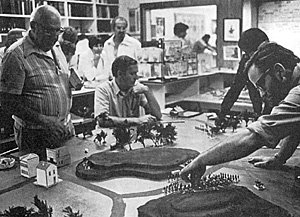 In the last two installments I discussed the development of recreational wargaming from Robert
Lewis Stevenson's contribution in the 1890's through H. G. Wells, Shambattle, and Captain Sach's wargame. The only bright spot between Sachs and the early 1950's was Fletcher Pratt's naval wargame rules which were first published in the 1940's. Pratt's rules served as a model for most tactical naval rules to follow and, indeed, the rules themselves are still
popular today.
In the last two installments I discussed the development of recreational wargaming from Robert
Lewis Stevenson's contribution in the 1890's through H. G. Wells, Shambattle, and Captain Sach's wargame. The only bright spot between Sachs and the early 1950's was Fletcher Pratt's naval wargame rules which were first published in the 1940's. Pratt's rules served as a model for most tactical naval rules to follow and, indeed, the rules themselves are still
popular today.
At right, game at the Soldier Factory, circa 1975.
But, generally, insofar as wargaming was concerned, the United States in the early 1950's was something of a desert. From the surface it looked barren but if you knew where to look you might find signs of primitive life. There was, however, little, if any, communication among these few and far between oases of gaming. Games were played with 54mm figures using modifications of the rules discussed last time or home-grown varieties. Gamers usually kept their hobby a secret for fear of being accused of "playing with toy soldiers" or even being warmongers (although that epithet was more frequently used in the late 1960's and early 1970's).
Then, as with all religions and sciences there arose in the West a prophet who sought to b;ing together the true believers. Jack Scruby had a vision for wargaming which involved establishing a network of wargamers sharing rule ideas, sharing figures, sharing battle plans, and even sharing games played by mail.
I think we can safely say that when we consider all the evidence in the paternity suit of organized wargaming there is no question that Jack is the guilty party. He provided the two crucial elements necessary to move wargaming from an activity of a few isolated individuals to the massive hobby and business that it is today. Those two elements are a stable source of figures intended for gaming and a communication network through which people could share ideas.
As long as game players were dependent on non-game oriented sources for their figures, they would be forced to spend much time converting commercial figures to their own needs or creating and molding their own figures.
Both activities would take time away from gameplaying and also preclude the less handy souls from the hobby. Jack undertook the task of furnishing people with "wargame figures" instead of "toy soldiers" used for wargames.
Until individuals have an opportunity to learn what others with the same hobby are doing there tends to be little development as each person pursues his or her own ideas with incremental changes over time. Only when individuals interact through the sharing of ideas will there be dramatic growth in any endeavor. Jack Scruby facilitated the needed medium for the growth of wargaming by publishing three successive wargaming magazines -- War Games Digest (not to be confused with the recent magazine with a similar name, Wargamers Digest), Table Top Talk, and, lastly, The Miniature Parade.
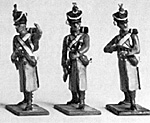 Jack entered the hobby in about 1952 playing with toy
soldiers -- 54mm Britains, Minots and the like (at right, 54mm Napoleonics made in 1953). See pp. 51 to 79 of Bob Bard's Making and Collecting Military Miniatures for some great pictures of those old games. He was an active figure painter and converter. At various
figure collector meetings in California he ran into others with a shared interest in gaming. The next few years were spent finding and corresponding with other like-minded individuals in the United States and England.
Jack entered the hobby in about 1952 playing with toy
soldiers -- 54mm Britains, Minots and the like (at right, 54mm Napoleonics made in 1953). See pp. 51 to 79 of Bob Bard's Making and Collecting Military Miniatures for some great pictures of those old games. He was an active figure painter and converter. At various
figure collector meetings in California he ran into others with a shared interest in gaming. The next few years were spent finding and corresponding with other like-minded individuals in the United States and England.
Breakthrough
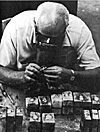 In 1955 Jack conceived of the idea of making figure
molds using RTV rubber rather than the conventionally used
plaster of Paris. He says that as far as Dow-Corning
(makers of RTV) knows, he was the first person to use RTV
in this way. His innovation was a major break-through for
figure making. It was now possible for a person to produce
large numbers of figures from a single mold. At right, Jack casting circa 1961.
In 1955 Jack conceived of the idea of making figure
molds using RTV rubber rather than the conventionally used
plaster of Paris. He says that as far as Dow-Corning
(makers of RTV) knows, he was the first person to use RTV
in this way. His innovation was a major break-through for
figure making. It was now possible for a person to produce
large numbers of figures from a single mold. At right, Jack casting circa 1961.
Plaster of Paris is difficult to cast with and very limited in both design potential and quantity of output. The other alternative for moldsmaking was the very expensive metal type used by commercial firms. With RTV, Jack could put figures into the hands of gamers in large numbers and great variety.
The first United States (if not world) wargamer's convention was organized by Jack in 1956. Some 14 players attended, all of whom used 54mm figures. Indeed, there really was not much else available. Thomas Figures began production of 20mm American Civil War figures in the early 1950's but that was about the extent of non-54mm figures. The success of the convention coupled with the potential for the mass production of figures led Jack in 1957 to undertake two ventures which set organized wargaming on the course which led it to the phenomena we have today.
Two Ventures
These two ventures were the publication of War Games Digest and the opening of Scruby Miniatures. In undertaking these activities Jack took a personal step never before attempted by anyone -- he became the first professional wargamer in the sense that he was devoting his life to this hobby. While he did have some other source of income wargaming was to be his source of livelihood for the future.
War Games Digest (WGD) was the formalization of an informal network of some 40 gamers in the United States and England. Jack had been corresponding with all of them for a number of years and decided that it would be far simpler to have a newsletter which could circulate among the group. This group comprised the "Old Guard" of wargaming.
As a sidelight, let me mention that one cannot help but notice a strange phenomena when looking over this list. Here are the men who gave the hobby most of the basic ideas of gaming still in use but where are they today? Those from the United Kingdom are, for the most part, still appearing in print in English magazines. The Americans, on the other hand, have not been heard from for many years. WGD, and later Table Top Talk, were filled with articles by these early hobby devotees but not one of them appears in recent publications. In a future issue, I hope to answer the question of what the Old Guard is doing today.
WGD was published four times a year and each issue had about 40 pages (few ads, mostly text) and sold for $4.00/year. In the first year came major breakthroughs in gaming. One article expanded on H. G. Wells' idea of moving troops around inside boxes by suggesting that figures be put on trays, moved into battle and then deployed as they came into contact but still using individual figures as the game pieces. Another article appeared suggesting the use of special troops such as lights, grenadiers and sappers.
This may not sound very significant until one remembers that hitherto games were fought with only "infantry", "cavalry", and "artillery". Rules were general -- covering all historical periods. A Napoleonic battle differed from an American Civil War game in that the figures were different, i.e., an ACW game used ACW figures while a Revolutionary War game was played with figures attired in 17th century uniforms. There were no historical differences built into the rules, nor was army organization historically grounded.
That is to say, no one used figure to man ratios and related the number of troops in an actual unit to the number of figures in the wargame unit.
Each army would have regiments of horse and foot of a fixed number regardless of what nationality was being simulated. All figures on foot were identical in capability; e.g., all fired the same distance, rate, and with the same effect, all moved the same distance and meleed equally. Likewise, ali troops on horseback were cavalry and fought equally well.
Thus, when in the pages of WGD it was suggested that foot figures could be functionally differentiated into light, grenadier, line, militia or what- have-you, it was quite a breakthrough. And one could have light cavalry, heavy cavalry, even lancers. Wargaming was now getting interesting.
One of the first contributors to the early pages of WGD was Charles Sweet. Charlie, too, is an important figure in American wargaming yet he never published a magazine, sold figures or even published a set of rules. While the many ideas for gaming he developed would be sufficient to get him into the Wargamers Hall of Fame, he can be best remembered as the man who brought wargaming "out of the closet" and made it an acceptable hobby among adults.
But that's yet another story, so let me return to one of his contributions to WGD -- that being the idea of special rules for Medieval games. No previous set of published rules had even considered the pre- gunpowder era. Charlie now suggested that one could find a use on the table top for all of those beautiful knights and castles everyone had on hand. This suggestion was but the first of many from Charlie.
Company
As I mentioned, besides beginning WGD in 1957, Jack also opened Scruby Miniatures (SM). The first and now oldest company devoted to the production of figures for wargaming. Little, I suspect did Jack realize that one day the hobby could support anything like the number of firms extant today. For almost fifteen years, SM was the only United States gaming figure manufacturer.
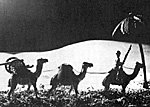 Jack began with 30mm figures (as at right, early colonial figures) selling for 15
cents for infantry and which were cast in type metal
(a brittle lead alloy used for printing type). About this
time, SAE introduced the painted 30mm figure. How
many of you readers recall those wonderful already-
painted 5-for-75 cents SAE figures in their cellophane-
covered green boxes with the list of available figures
on the back. So between Jack and SAE, 30mm
figures got off to a great start. They were billed as the
"in" scale for gaming -- taking up less space and
costing less than the previously used 54mm's.
Others got on the bandwagon and soon Stadden,
Suren Command Post and JAL were in the business
too. Figures of 30mm became the standard for the
next ten years.
Jack began with 30mm figures (as at right, early colonial figures) selling for 15
cents for infantry and which were cast in type metal
(a brittle lead alloy used for printing type). About this
time, SAE introduced the painted 30mm figure. How
many of you readers recall those wonderful already-
painted 5-for-75 cents SAE figures in their cellophane-
covered green boxes with the list of available figures
on the back. So between Jack and SAE, 30mm
figures got off to a great start. They were billed as the
"in" scale for gaming -- taking up less space and
costing less than the previously used 54mm's.
Others got on the bandwagon and soon Stadden,
Suren Command Post and JAL were in the business
too. Figures of 30mm became the standard for the
next ten years.
War Games Digest entered its second year with an article on Morale in Wargames. Morale was not a new concept; recall Robert Lewis Stevenson tried to incorporate the idea into his games but could not bear to see his favorite troops flee the battle on bad dice throws.
So, for over 100 years the steadfast lead soldiers fought to the last man regardless of their "personal feelings" in the matter. I guess it was appropriate that in the time of national concern for civil rights and social welfare, someone considered the feelings of the wargame combatants too. My research indicates that the person who made that consideration was Ted Haskill of Lansing, Michigan. A man of great imagination and innovation, Ted was one of the Old Guard who contributed much to the origins of modern wargaming. His Bluvian Chronicles were modelled after the reports of R. L. Stevenson and are themselves classic battle reports .
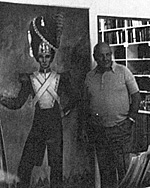 At right, Jack poses with an old friend!
At right, Jack poses with an old friend!
The year 1959 saw Jack purchase a printing shop to handle magazine and catalog production (and perhaps a source for type metal?). In that same year, Jack began the process of figure deflation with the introduction of the Greenwood 20mm figure into the U.S. While the Thomas range of 20mm Civil War figures had been available for some time, the Greenwood figures were much more extensive in their historical coverage and facilitated gaming in many periods at this smaller scale.
A highlight of the 1959 volume of War Games Digest was an article by Gerry DeGre on the use of written orders each turn during a game. At last the final vestige of connection to that archaic predecessor of wargaming, chess, could be severed. Now one could turn from the unrealistic alternative move game to the simultaneous move. Gerry DeGre is, by the way, another of those Old Guards from whom we have heard little in the recent era. As founder of the Model Generals Club and innovator of many ideas he made important contributions to the hobby.
The sixth decade of the twentieth century was the turning point of the hobby. Thanks to the leadership of Jack Scruby, the U.S. was no longer a vast desert for wargaming. While not yet the jungle we have today fertile meadows were already sprouting the fruits of many ideas and the soil was cultivated for future harvest.
Two Editions
In 1960 WGD split into two editions, U.S. and U.K. Don Featherstone makes his editorial debut in the hobby as co-editor with Tony Bath of the U.K. edition.
One issue that year began a controversy as of yet unresolved: should battle reports be written as historical accounts or game commentaries? (As a footnote here, let me. mention that in 1960 Airfix Ltd. introduced their line of soft plastic HO/OO figures which began the trend to the 25mm standard figure.)
War Games Digest closed publication in 1961 after something of a rift between the various editors. Each editor had a view of what the hobby was about (and in retrospect, not all that different) and what the editorial and article selection policy should be, so they split up one of the best opportunities for Anglo-American cooperation since the Normandy invasion. Don went on to publish Wargamers Newsletter which has expressed the British view of gaming monthly and without lapse since then. Quite a feat in this hobby!
One of the last articles to appear in WGD was one by yet another Old Guard -- Joe Morschauser -- on the possibility of glueing figures to movement stands and then using a roster system to keep track of casualties. Now one could move armies around the table, not just single figures. This suggestion met initial resistance by those who claimed not to like the paperwork but whom I think hated to give up fondling the toy soldiers -- those last links to a happily remembered childhood. Jack found time to publish his own set of rules, The Strategic-Tactical War Game, which collected many of the ideas expressed over the years in WGD.
Although War Games Digest was now put out to pasture, Jack was still holding reins of leadership on the U.S. wargaming scene. In 1962 he started Table Top Talk ( TTT), first only as a promotional piece for Scruby Miniatures but later it became THE U.S. wargaming magazine. An early issue reported on the first "big" historical wargame. John Candler and Duke Siegfried organized a game of 8,000 30mm Napoleonic figures. A second big game was held in Dayton in 1963. TTT reported it as having over 8,000 figures on 4 6' x 12' tables. Fifteen players were involved included Duke Ted Haskill, Stan Glanzer, and Fred Veitmeyer.
Third Phase
Wargaming had entered its third phase of development -- the historically based wargame. Rules were no longer ahistoric but rather captured the tactics, weaponry and organization of historical eras -- ancient, medieval, Napoleonic, ACW, modern. The pages of TTT brought the message to gamers around the country. Fred Veitmeyer, for example, brought the perspective of a scholar to gaming -- demanding historical evidence for each rule or aspect of organization.
During the early 1960's specialized journals arose devoted to specific periods and combining history and gaming. Examples of these are The Slingshot (ancients), Bulletin of the Colonial Wargame Society -- later Savage and Soldier, The Bayonet (horse and musket), The Napoleonic Journal. TTT also carried historical articles as well as technical ones related to morale, visibility, variable combat strength, written orders, decimal calculations, combat points. Don't think other topics were excluded. In 1966 Leo Cronin suggested a "mythical" wargame based on the Fellowship of the Ring and Joe Morschauser wrote about a skirmish game with individual figures.
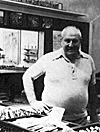 Scruby Miniatures (at right, Jack in the Sales Room) was also in the forefront of the
"historical revolution", filling the need for new periods
and specialized troops for each period. The
Napoleonic period required hundreds of figures for
the five major powers plus the many minor states.
Thanks to research and efforts by many historically
minded gamers, one could now choose among
dozens of troop types in the Napoleonic period
alone -- line, grenadier, highlander, lights, rifles,
fusilier, old guards, jagers, hussars, dragoons, light
dragoons, young guards, lancers, cuirassiers,
Cossacks, Mamelukes, marines -- advancing, firing,
onguard, charging, marching -- the
combinations were almost endless.
Scruby Miniatures (at right, Jack in the Sales Room) was also in the forefront of the
"historical revolution", filling the need for new periods
and specialized troops for each period. The
Napoleonic period required hundreds of figures for
the five major powers plus the many minor states.
Thanks to research and efforts by many historically
minded gamers, one could now choose among
dozens of troop types in the Napoleonic period
alone -- line, grenadier, highlander, lights, rifles,
fusilier, old guards, jagers, hussars, dragoons, light
dragoons, young guards, lancers, cuirassiers,
Cossacks, Mamelukes, marines -- advancing, firing,
onguard, charging, marching -- the
combinations were almost endless.
Then there were ancients, medievals, colonial, Revolutionary War, Civil War, World War I, World War II, Mexican War, FrancoPrussian, etc. If you could not find what you wanted Jack would accept special figures on a commission basis. (I always wanted to request mounted guard cuirassier sapper with lance and rifle, but was afraid to face the wrath of Fred V.)
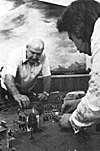 Jack and Phil Hausen in a game at The Soldier Factory -- 1975.
Jack and Phil Hausen in a game at The Soldier Factory -- 1975.
On the tenth anniversary of Scruby Miniatures, 30mm figures were going for 18 cents, an increase of 20% over ten years. Even so, Jack was complaining about the cost of lead going "sky high". At that time he was casting about 70,000 figures per year, a figure which must represent a large percentage of all lead figures then being sold in the world.
By comparison, today a firm like Miniature Figurines, Ltd. (USA) has the technology to cast that many 25mm figures in two weeks and does sell that much in less than two months. Considering Miniature Figurines production along with that of Ral Partha, Grenadier, Heritage, Hinchliffe, Dragontooth plus the other, smaller, U.S. firms, we might assume that fiften years later 70,000 figures are sold in two weeks. Adding U.K. production and all 15mm's as well, might I even guess that 70,000,000 is not out of line for a year's world production of lead gaming figures?
In 1965 Jack released the first figures designated as 25mm (15/16ths of an inch high). These initial 25's were colonial figures costing 15 cents for infantry and 30 cents for cavalry and were shown at the 150th anniversary of Waterloo Convention in London. Jack introduced this scale to be compatible with the Airfix plastic figures which were too big for 20mm, yet too small for 30mm.
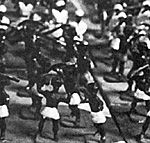
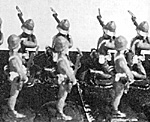 At right and left, the first "25mm" lead figures.
At right and left, the first "25mm" lead figures.
TTT ceased publication during 1967 and was replaced for two years by The Miniature Parade, a magazine, as Jack said, for "advanced gamers". The hobby had indeed come a long way such that participants could be divided into beginning and advanced. The last two years of the 60's saw a tremendous growth in the hobby. Conventions were being held regularly, 3-4 magazines were being published, including The Armchair General, The Courier, Miniature Warfare, Strategy and Tactics' "Wargamers Corner", Wargamers Newsletter. Wargame articles were also appearing in magazines like Meccano, Airfix and Tradition. So, in 1969, the last regular Scruby publication ceased. Although a one-issue encore of War Games Digest was printed in 1971 and a number of Scruby Miniature newsletters appeared during the 70's.
The figure side of the hobby also changed at the turn of the decade. A half-dozen firms were now in business, including Miniature Figurines (beginning the "millimeter race" with the introduction in 1968 of the "big" 25mm figures), Hinton Hunt, Lamming, Douglas, SEGOM, McEwen, Les Higgins and Bugle and Guidon. In 1970 Jack merged with Ambrite Industries in an attempt to streamline the business and carry it out in a more mass production method. "Ready Cast" figures were released at 15› for 25mm infantry. These figures were cast in advance rather than in response to a particular order as had been Jack's procedure in earlier years.
In 1970 Jack had a heart attack which slowed him down a little bit but he stayed active in the hobby. In 1972 he invented the 9mm figure, compatible with N-gauge train equipment -- as an alternative to "Micro" 1/300 scale figures but in the same year Peter Laing released the first 15mm figures which caught the public's fancy as the new scale of the late 70's and 1980's.
Although strictly a historical gamer, Jack did try his hand at fantasy figures in 1975. He's still in the hobby, creating, casting and selling wargame figures and has a little shop in Cambria, California. Recently, he returned to one of his early loves -- sculpting 54mm figures in the style of old toy soldiers. Can anyone be a serious gamer and not have a unit of Scruby figures in one of their armies?
As publisher of War Games Digest, Table Top Talk, and The Miniature Parade, he set the standard for wargame publications and served to bring together the ideas of a number of creative individuals between the years 1957 and 1970. All of the basic concepts which set modern wargames apart from the simple rules of Wells and Sachs can be traced to articles appearing in these three journals.
It must be said, however, that even though Jack was responsible for much of what we have in the hobby today in the way of complex and historically based rules, he, himself, always stressed the FUN aspect of the hobby. Countless editorials sought to remind the faithful not to take themselves too seriously, this was after all a hobby, a form of recreation. Jack never failed to strike down anyone who would set himself up as the final word in gaming and most importantly, he never tried to set himself up as THE authority. His style was to tell you what he did, suggest that you use and change his ideas as you saw fit and wished you good luck and much fun. l am sure I speak for all gamers in the world today when I say to Jack, good luck, live long and propser, may the force be with you and, most of all, THANKS.
Back to Table of Contents -- Courier Vol. 1 #5
To Courier List of Issues
To MagWeb Master Magazine List
© Copyright 1980 by The Courier Publishing Company.
This article appears in MagWeb (Magazine Web) on the Internet World Wide Web.
Other military history articles and gaming articles are available at http://www.magweb.com